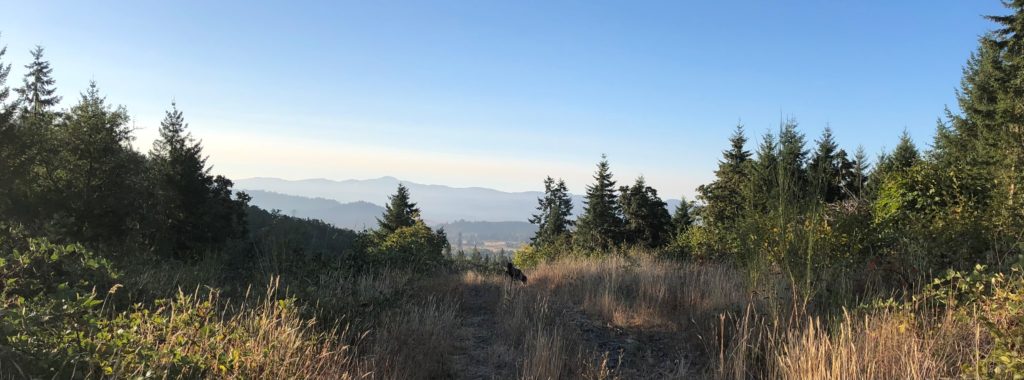Forest & Wildlife
Savannah and Woodland Enhancement
A property owner contacted the Upper Willamette SWCD about his concerns for the legacy of his land for future generations. Oak savannas and oak woodlands are the most imperiled habitats in the Willamette Valley due to fire suppression and land use conversion. His small grant funded trimming, thinning, mulching, and planting of oak trees as well as the removal or girdling of other tree species. Invasive vegetation, such as blackberries, which displace and prevent native plant growth, were removed and native vegetation planted to reduce erosion. The property owner now has a lasting oak savanna legacy to pass on for generations to come.
Pure Water Partners (PWP)
PWP protects riparian forests for wildlife habitat and drinking water.
We currently work with over 80 landowners to provide technical assistance and get them signed up for riparian restoration and protection agreements with the Eugene Water & Electric Board.
- A landowner contacted us about the potential for the long-term protection of the creeks and creek side vegetation growing on his family owned legacy ranch. The conservation specialist determined that the riparian and special habitat areas on this property are eligible for a long-term protection agreement. The property includes special habitat features, such as, wetland and oak habitats. The landowner is also working with our partners at National Resources Conservation Services (NRCS) to restore the oak habitat, fence off cattle from the lower reaches of the creeks, and plant native riparian vegetation in areas previously disturbed by livestock. This landowner is excited that he can be rewarded for his efforts to do the right thing for the natural systems, create unique habitats for endangered species, and protect drinking water quality for downstream users.
- A landowner contacted us about her family’s legacy woodlot as a special piece of land to her and her family. She wants to protect it for the future generations and contribute to the health of the river and clean drinking water for future generations. Her 7-acre property qualified for protection because it is a thriving, healthy riparian forest. She signed the acreage into a long-term agreement that will help ensure healthy aquatic habitat and clean drinking water now and into the future. It also provides her with support to keep the family owned property for future generations.
National Resources Conservation Services (NRCS)
The Upper Willamette SWCD works closely with the Natural Resources Conservation Service (NRCS) to implement projects that improve forest health and biodiversity. Several projects have been implemented to reduce tree density. These thinning projects reduce fire hazard, reduces the potential for pests to infest forest stands and also allows sunlight to reach the forest floor. Under a closed canopy forest there is no understory vegetation. Sunlight allows ferns, salal and native shrubs to establish. In addition to thinning, native trees and shrubs are planted to improve the forest biodiversity. Not all forestland is appropriate for Douglas fir planting. Some soils are too wet and other soils are too shallow and rocky. Stressed trees are more susceptible to pests. By replacing stressed Douglas fir with species tolerant to the local growing conditions pest pressure is reduced. As plant diversity increases so does wildlife habitat. Since much of Lane County is forested the Upper Willamette SWCD has worked closely with NRCS to create funding opportunities for forest landowners.
National Resources Conservation Services (NRCS) Website
Deer Creek Project (with ODF/MWC)
The Upper Willamette SWCD partnered with the Oregon Department of Forestry (ODF) and the McKenzie Watershed Council (MWC) to support the documentation of the linked physical and ecological responses to the recent “Stage 0” restoration on Deer Creek. Stage 0 restoration intent is to restore natural processes, which will create and maintain habitat over time. An enhanced understanding of the short- and long-term impacts of this restoration on focal species, water quality, and physical habitat will directly inform the development of future restoration, enhancing outreach to raise awareness and understanding of this restoration approach. To see more about this project please visit the McKenzie Watershed Council Deer Creek Restoration Project Web page.
Additional Resources
- Current Fire Season Map (ODF)
- Fire restrictions – public and industrial (ODF)
- FIREWISE Grant Program for rural landowners (Lane County)
- Highly flammable plant list (Lane County)
- Less flammable plant list (Lane County)
- FIREWISE tips for creating defensible space (Lane County)
- FIREWISE construction checklist (Lane County)
- Air Quality Index (LRAPA.org)
- Fire Resistant Plant Guide for the Willamette Valley (OSU Ext)
- Fire Resistant Plant Guide for the PNW (OSU Ext)
- Fire danger and weather forecasts (ODF)
- Advanced Wildfire Risk Explorer (ODF & USFS)
- Daily wildfire situation map (NWCC)
- City of Eugene Wildfire website
- OSU Extension Forest Health and Management
- Natural Resources Conservation Service Healthy Forest Reserves Program (HFRP)
- Natural Resources Conservation Service Environmental Quality Incentives Program
From weather to pests, each American farmer faces a unique set of challenges. The Environmental Quality Incentives Program (EQIP) provides financial and technical assistance to agricultural and forestry producers to address natural resource concerns and deliver environmental benefits such as improved water and air quality, conserved ground and surface water, reduced soil erosion and sedimentation, and improved or created wildlife habitat. - Oregon Department of Forestry, Helping Landowners Website
